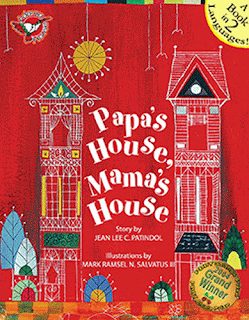Papa's House, Mama's House
This striking story
was written by Jean Lee C. Patindol and illustrated by Mark Salvatus. This book
received the 2004 Grand winner PBBY Salanga Prize, PBBY Alcala Prize.
STORY:
In Papa’s House,
Mama’s House three
siblings divide their time between the homes of their mother and father. Some
things are the same in both households (they eat some of the same foods, play
the same games), but others are not. Whereas “in our home with Papa we have
many rules. I don’t remember all of them.” in Mama’s house “We only have two
rules: “ ‘Be honest’ and ‘Clean up your own mess’.”
Papa’s
House, Mama’s House approaches the topic of
divorce, a situation experienced by more and more kids throughout the world,
from the point of view of one of the children in the family. From a positive
angle not always present in chidren’s books (which tend to portray divorce as a
family “problem”), the young narrator reveals that, despite the changes in his
routine, his parents’ love for him is still the same. Indeed, Mark Salvatus’
multi-media illustrations, while detracting from the story at times with their
bright red double-page spreads, provide an overall tone of happiness to the
narrative. That doesn’t mean, however, that there aren’t mixed feelings to be
dealt with: “Sometimes it makes me tired going back and forth… Sometimes it
makes me sad, too.”
An
author’s note at the end of the book explains the story was motivated by the
author’s own divorce and desire to explain to her son that their new
situation needn’t change his idea of what it means to be a family. “It’s
interesting how the way we define our concepts in our minds affects the degree
to which we gracefully accept or struggle with the realities in our lives,” she
offers.
The
author also says in her note: “In an increasingly complicated world… I strongly
believe in bringing up children with a respect and appreciation for diversity
and practical examples of struggling to learn how to live as peaceably and
harmoniously as one can, amidst differences”. And, true to her intentions, she
ends the story with the celebration of the young narrator’s birthday party,
where Mama and Papa stand side by side, after working as a team, “peaceably and
harmoniously,” to put the party together.
This is a lovely and honest book to help children understand that there are many ways to be - and remain - a family.
ILLUSTRATION:
When
words can't describe how one feels, pictures can. This is how Sergio Bumatay perceived, reviewed and interpreted Papa's House, Mama's House:
 |
| Pictures from Sergio Bumatay's blog |
The
illustrations have bold strokes of provocative colors with small sketchy
figures. The heavy painterly style and scratch techniques work both ways: it
may either suggest the deep unsettling feelings of the character perfectly
expressed through colors and strokes, or the style symbolizes the love of
parents for the character which doesn't diminish despite their situation. While
looking at the illustrations, you can actually feel those emotions as you read.
The small figures may connote that we play deaf in children's honest and pure
voices about issues and they should also matter in adult decisions, no matter
how young they are. How often do we disregard or underestimate a child's
understanding?
 |
| Pictures from Sergio Bumatay's blog |
The
illustrations of Papa's House, Mama's House is a good example of how style may
expressively convey emotions.
PS. For more reviews on book illustrations, you may read Sergio Bumatay's blog: http://serjbumatay.blogspot.com/2011/06/why-i-love-papa-and-mamas-house.html

Comments